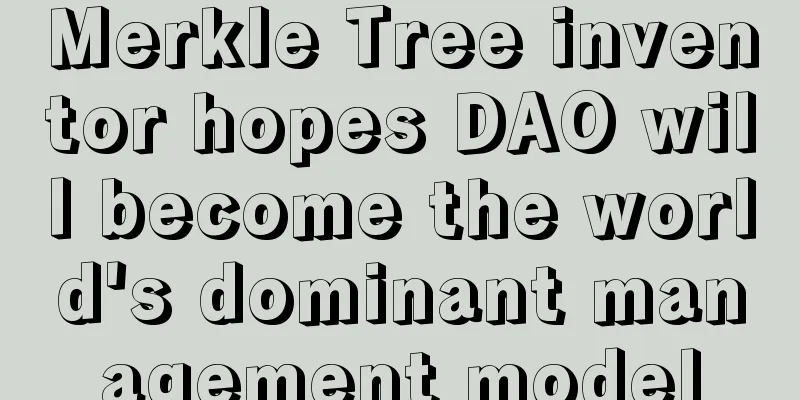Merkle Tree inventor hopes DAO will become the world's dominant management model

Translation: Annie_Xu The inventor of the encryption tools at the heart of all blockchain technology has spent the next few decades working on quantum computers and molecular printing in order to invent technologies that could defeat disease and extend life. Ralph Merkle and his colleagues in the field of nanotechnology are trying to use viruses and other technologies to develop microscopic devices that can assemble molecules at the atomic level, a technique known as molecular manufacturing. In this emerging industry, small machines could theoretically be used to assemble atoms into molecules, with potential applications including quantum computers, new forms of energy storage, and tiny implantable machines for semi-automated medical treatment. Ralph Merkle But as Merkle's work progressed, the 1998 Feynman Prize winner for theoretical nanotechnology began to worry that the results of his efforts could threaten human survival.
Back to square one In his quest for a new governance model that could better protect the world, Merkle found himself back at square one. The power to reshape governance lies in the Merkle Tree, which bears the same name as himself. Merkle Tree, known as authenticated digital signature when it was invented in 1979, enables cheap and reliable encryption of data by converting and calculating blocks of information into unique long code strings. The latest blocks of information, or leaves of the Merkle tree, are strung together to form so-called branches, which then trace back to a single string of numbers and letters called the Merkle Root, which contains all the previous information. This block hashing algorithm is at the heart of the Bitcoin and Ethereum blockchains. Merkle then became an advisor to the Ethereum project in May 2014, and three months later, another inventor’s document caught his attention. The document by Ethereum source code author Vitalik Buterin discussed ways for distributed autonomous organizations, or DAOs, to program various governance models into software. Because DAO is designed without leadership, its underlying software and management model rely on a series of smart contracts. Although Vitalik Buterin’s article “An Introduction to Futarchy” outlines several alternative governance models that could advance DAOs in the future, the core of the article is the concept of Futarchy, which was invented in 2000 by Robin Hanson, a researcher at George Mason University and chief scientist at market research company Consensus Point. Buterin believes that Futarchy’s management model will eventually lead to a new leadership model, where the precise probability of market predictions will control management rights, facilitate the implementation of events and avoid dependence on a single leader. Reliance on market forecasts The key difference between a forecast market and an opinion poll, a regular election or a board vote is that it does not concern the expectations of the participants, but rather their predictions. Participants then purchase shares with U.S. dollars at places like the Iowa Electronic Markets, giving them the right to express their predictions, with the amount they payout tied to the accuracy of their predictions. If the prediction is accurate, you will be rewarded accordingly. Because forecast markets allow experts in a field to profit from their research and knowledge, they are increasingly considered more accurate than opinion polls, with a recent survey putting the difference at 74%. Merkle said:
DAOs, democracy and governance In May 2016, Merkle published an article on its website titled “DAOs, Democracy, and Governance.” This 27-page manifesto includes the following content: how market predictions determine a country’s membership, calculate the collective welfare of citizens, replace government agencies such as the U.S. Congress, pass bills, elect presidents, and prevent wars. Merkle said that citizens of a DAO democracy can adopt any practical solution that minimizes loss of life. This theory applies not only to war, but to all conflict situations.
According to the Merkle article, the DAO prototype is actually Bitcoin, which is decentralized, autonomous, and has a certain degree of organization, so please ignore the recent controversy about block size. After all, Bitcoin has been running continuously for seven consecutive years and has reached a market value of $1 million. No matter how you measure it, it is a successful experimental project. Get rid of criticism The DAO and prediction markets have had their fair share of critics and detractors. The DAO, the first large-scale DAO, had its management model exploited by an unknown person or organization, and suffered a significant loss of the $150 million initially raised. Before the release of DAO2.0, there were at least ten software vulnerabilities that people could think of that could be exploited. Over the years, the media has published articles criticizing Futarchy, mostly focusing on how market-based technology implementations could be used to harm the interests of the majority and benefit a few or a single individual. But for Merkle, the fundamental ingredient of DAO democracy is the ability to automatically improve the core software. He predicts that the DAO ecosystem will undergo a Darwinian evolutionary competition to fundamentally improve the way it operates. Before a true DAO democracy can be achieved, Merkle said its citizens must get comfortable with the concepts of prediction markets, decentralized autonomous organizations, and cryptocurrencies, and then explore small-scale use cases. He highlighted that student organizations or other small institutions would be ideal candidates for such testing. Looking at the way DAO democracy works, the next logical area to explore is "bankrupt cities or countries without laws. They don't lose much by trying experiments with unknown results, but if they succeed, they can get rid of many difficulties." Implementation Last week, Merkle discussed the article, as well as the broader context of blockchain and Ethereum, with members of the Decentralized Autonomous Society in Palo Alto, California. Merkle said that most projects in the field today are led not by political leaders but by the governed, especially computer scientists. The reason is that cryptographic and other technical knowledge is necessary to determine the direction of exploration. But as the theory becomes more popular and use cases grow, blockchain scientists will work with politicians.
|
<<: Myanmar trials blockchain technology for microfinance
Recommend
A woman has a mole on her left eyelid. The meaning of a mole on her left eyelid
We all have moles, and most of them grow on the f...
Your forehead determines your future. Will you be a successful youngster or a late bloomer?
Your forehead determines your future, whether you...
Toes with these three characteristics are destined to have a good life
Although people's toes are similar, careful o...
A complete analysis of the auspicious face of a rich nose
The nose represents a person's wealth in physi...
What is the difference between people with long and short middle fingers?
The middle finger belongs to Saturn, and its own ...
How to tell a girl's love luck from her ears
In physiognomy, there are many mysteries hidden i...
Analysis of the face of big mouth and small ears
People with big mouths have better facial features...
Cryptocurrency has gone mainstream in the U.S., and the era of hyper-adoption will come soon
The Super Bowl finals ended yesterday, and the Lo...
What does three white eyes mean? Analysis of the face of three white eyes
Three-white eyes refer to a type of eye shape. Th...
A complete illustration of the face of a woman who is unlucky in marriage
It is a very sad thing for a woman to be unlucky ...
A woman with this face is destined to be a rich wife and will marry a rich husband.
I believe that most women have the idea of beco...
The facial features of a good man
The facial features of a good man, the facial fea...
Will the use of blockchain technology in the Internet of Things bring more or less freedom?
In a South Park episode titled 'Crème Fraîche...
What happened to the monkey named "Bitcoin"?
In the last book, it was mentioned that the monke...
Pregnant woman's face to predict the gender of her baby
Pregnant woman's face to predict the gender o...









